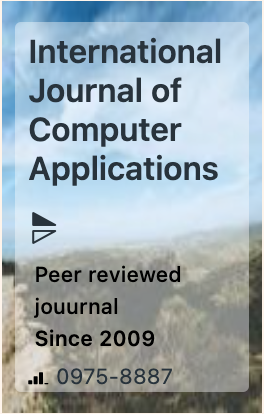The week's pick
Random Articles
Reseach Article
Ensemble Learning Approach to Fraud Detection in Cryptocurrency Blockchain
| International Journal of Computer Applications |
| Foundation of Computer Science (FCS), NY, USA |
| Volume 186 - Number 65 |
| Year of Publication: 2025 |
| Authors: Alowolodu Olufunso Dayo |
 10.5120/ijca2025924459
10.5120/ijca2025924459
|
Alowolodu Olufunso Dayo . Ensemble Learning Approach to Fraud Detection in Cryptocurrency Blockchain. International Journal of Computer Applications. 186, 65 ( Feb 2025), 35-41. DOI=10.5120/ijca2025924459
Abstract
Blockchain, an emerging and very important technology in the financial industry is facing many challenges especially security wise. The decentralized nature and characteristics of the blockchain makes it more difficult for conventional intrusion detection and prevention systems to identify and prevent fraudulent activities in real-time. This has posed serious challenges for fraud detection systems, thereby contributing to the wider attempts being made to ensure secure blockchain environments and build trust in cryptocurrency markets. This research hereby proposes an ensemble model approach to detect fraudulent cryptocurrency transaction. The proposed model will combine two deep learning algorithms namely, Recurrent Neural Networks (RNNs) and Long Short-Term Memory (LSTM). The ensemble model consistently demonstrated high precision and at the same time ensured that the transactions that were labelled fraudulent were indeed captured as true, while sustaining high recall to identify most of the fraudulent activities. This work has shown that ensemble learning can generate a more robust and accurate fraud detection system rather than the conventional or single models and this makes the model more relevant in situations with highly imbalanced datasets like cryptocurrency transactions like blockchain.
References
- Ding, W. and Marchionini, G. 1997 A Study on Video Browsing Strategies. Technical Report. University of Maryland at College Park.
- Bartoni, A. (2017). Ethereum phishing attack results in $70 million theft. Forbes. Retrieved from https://www.forbes.com/sites/antonyleather/2017/06/20/ethereum-phishing-attack-results-in-70-million-theft/Buterin, V. (2013). Ethereum White Paper. Retrieved from https://ethereum.org/en/whitepaper/
- Chandola, V., Banerjee, A., & Kumar, V. (2009). Anomaly detection: A survey. ACM Computing Surveys (CSUR), 41(3), 1-58. https://doi.org/10.1145/1541880.1541882
- Chen, Y., Li, N., Zhang, J., & Shao, L. (2020). Survey of fraud detection research on blockchain. Proceedings of the 2020 International Conference on Big Data and Artificial Intelligence (BDAI).
- Conti, M., Kumar, S., Lal, C., & Ruj, S. (2018). A survey on security and privacy issues of bitcoin. IEEE Communications Surveys & Tutorials, 20(4), 3416-3452.
- Foley, S., Karlsen, J. R., & Putniņš, T. J. (2019). Sex, drugs, and bitcoin: How much illegal activity is financed through cryptocurrencies? The Review of Financial Studies, 32(5), 1798-1853.
- Goodin, D. (2017). WannaCry ransomware attack hits 150 countries. Ars Technica. Retrieved from https://arstechnica.com/information-technology/2017/05/wannacry-ransomware-attack-hits-150-countries/
- Han, J., Kamber, M., & Pei, J. (2011). Data Mining: Concepts and Techniques (3rd ed.). Morgan Kaufmann Publishers. ISBN: 978-0123814791
- Hussain, Y., Dai, T., Ti, Y., Huang, M., Chiang, T., & Liu, L. (2022). Feature Engineering and Resampling Strategies for Fund Transfer Fraud With Limited Transaction Data and a Time-Inhomogeneous Modi Operandi. IEEE Access,10, 86101-86116. https://doi.org/10.1109/ACCESS.2022.3199425.
- Kharif, O. (2014). Mt. Gox says it lost 850,000 Bitcoins in hack. Bloomberg. Retrieved from https://www.bloomberg.com/news/articles/2014-02-28/mt-gox-says-it-lost-850-000-bitcoins-in-hack
- Kim, J., Lee, S., Kim, Y., Ahn, S., & Cho, S. (2023). Graph learning-based blockchain phishing account detection with a heterogeneous transaction graph. Sensors, 23(1), 463. https://doi.org/10.3390/s23010463
- Kumar, A., & Sharma, I. (2023). Preserving Security of Crypto Transactions with Machine Learning Methodologies. 2023 International Conference on Sustainable Computing and Smart Systems (ICSCSS), 129-134. https://doi.org/10.1109/ICSCSS57650. 2023.10169192.
- Nakamoto, S. (2008). Bitcoin: A Peer-to-Peer Electronic Cash System. https://bitcoin.org/bitcoin.pdf
- Nakamoto, S. (2010). Bitcoin: A Peer-to-Peer Electronic Cash System. Retrieved from https://bitcoin.org/bitcoin.pdf
- Ngai, E. W. T., Xiu, L., & Chau, K. Y. (2011). Application of data mining techniques in fraud detection: A classification framework. Decision Support Systems, 50(3), 559-570. https://doi.org/10.1016/j.dss.2010.08.005
- Pahuja, L., & Kamal, A. (2023). Enlefd‐dm: ensemble learning based ethereum fraud detection using crisp‐dm framework. Expert Systems, 40(9). https://doi.org/10.1111/exsy.13379
- Quadir, A., Narayanan, S., Sabireen, H., Sivaraman, A., & Tee, K. (2023). A novel approach to detect fraud in ethereum transactions using stacking. Expert Systems, 40(7). https://doi.org/10.1111/exsy.13255
- Saxena, R., Arora, D., Nagar, V., & Chaurasia, B. K. (2024). Blockchain transaction deanonymization using ensemble learning. Multimedia Tools and Applications. https://doi.org/10.1007/s11042-024-19233-5
- Taher, S. (2024). Advanced fraud detection in blockchain transactions: an ensemble learning and explainable AI approach. Engineering Technology & Applied Science Research, 14(1), 12822-12830. https://doi.org/10.48084/etasr.664.
Index Terms
Keywords

